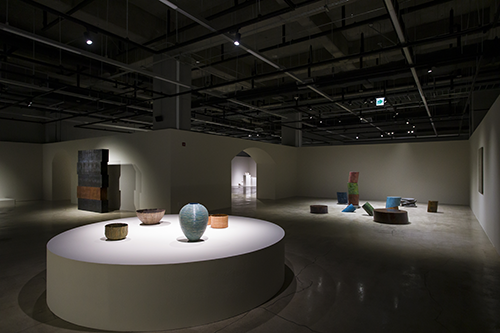-
-
Through an ottchil, traditional Korean lacquer or lacquering, curatorial exhibition, the Cheongju City Korean Craft Museum seeks to examine diverse aspects of ottchil while discussing the practical beauty that has developed with ottchil’s long history. As the title suggests, this exhibition’s keyword is “blackness,” or chilheuk (lit. “lacquer black”).
Period 2023-11-21 ~ 2024-01-14 Location Gallery 3, Korean Craft Museum Host Cheongju City Organize Cheongju Cultural Industry Promotion Foundation, Korean Craft Museum Author Kim Seongho, National Intangible Heritage Center, Kang Woorim, Kim Soomi, Noh Kyeongjoo, Jung Eunjin, Kim Ok, Park Seoungyeol, Lyu Namg won, Huh Myounguk
![]() Product description Voice guidance
Product description Voice guidance

Through an ottchil, traditional Korean lacquer or lacquering, curatorial exhibition, the Cheongju City Korean Craft Museum seeks to examine diverse aspects of ottchil while discussing the practical beauty that has developed with ottchil’s long history. As the title suggests, this exhibition’s keyword is “blackness,” or chilheuk (lit. “lacquer black”).
Koreans refer to thick darkness as being “like chilheuk.” One can ascertain how deeply ottchil culture permeates our daily lives through the word chilheuk, which means “black and shiny like lacquer.”
It is known that ottchil began around the third century B.C., in the Bronze Age, in Korea. Indeed, one can find efforts to collect quality lacquer to create lacquerware in History of the Three Kingdoms and The Veritable Records of the Joseon Dynasty, as one can verify Korea’s long lacquer culture in the numerous place-names related to lacquer-tree growing or lacquerware production throughout the country. What might be the reason ottchil culture, which is greatly influencing the language and even place-names we use, remains by our side for over two millennia? The traditional reason was probably because of ottchil’s effects.
Ottchil has been used as an all-natural finishing material and adhesive since lacquering wood or metal repels moths or prevents rusting while improving the heat endurance, and lacquering has aided many aspects of our living, from medicine to food.
After a long time, we today re-highlight the craft of ottchil surrounded by the issue of environmental friendliness, as we discover modern aesthetic sensibilities in it.
Together with the National Intangible Heritage Center, we composed this exhibition with nine artists in three parts to exhibit the traditional and modern ottchil craft’s lasting harmony. In the first part, From That Blackness, we introduce the works of Kim Seongho,
National Intangible Heritage Center Traditional Crafts Department Chungbuk Intangible Cultural Asset Number 27.
From cases and a hojokban (lit. “tiger-footed small table”) remarkable for their mother-of-pearl splendidly sparkling on a base of black lacquer and a letter/paper holder of the kind hung on walls in rooms or by building ledges to a horse saddle, one will be able to glimpse ottchil’s various uses and the efforts of master craftspeople who have dedicated themselves to lacquerware culture for lengthy time. The second part, From Quiet Light, is a variation of ottchil on various materials.
Through the four artists Kang Woorim, Kim Sumi, Noh Kyungjoo, and Jeong Eunjin, we present modern ottchil harmonizing with wood, ceramics, metal, and glass in this section. Also, viewers may meet a craft technique called kintsugi, which is a bit novel to us. The intention is to present another expansion of ottchil through kintsugi, the craft technique of mending broken pottery with unprocessed lacquer and decorating it with gold or silver powder.
For the final section, From Strength, it is now time to meet the layers of time hundreds of lacquer applications create.
There is a saying that ottchil lasts a thousand years. It means the material is that strong. Behind that strength are the artist’s actions.
The four artists we introduce in this part, Kim Ok, Park Sungyeol, Lyu Namgwon, and Huh Myoungwook, present in their respective ways ottchil as a material transcending craft to practice life.
Ottchil refers to applying the sap of lacquer trees. Unlike other craft fields, it is not just a material like ceramic minerals, glass, or metal and is a technique and the artist’s action in itself. Therefore, ottchil is also an art displaying qualities of time building up like the ottchil’s thickness, which the artist builds up layer by layer. The craft of ottchil, which has been continuing for two millennia, has perhaps been enduring the lacquer-black darkness as the ceaseless actions of countless people continued. We hope you will meet the time and profound flow ottchil has been continuing through the Cheongju City Korean Craft Museum’s current ottchil curatorial exhibition, From That Blackness.


 Callcenter
Callcenter Office Hours
Office Hours Deposit account
Deposit account


